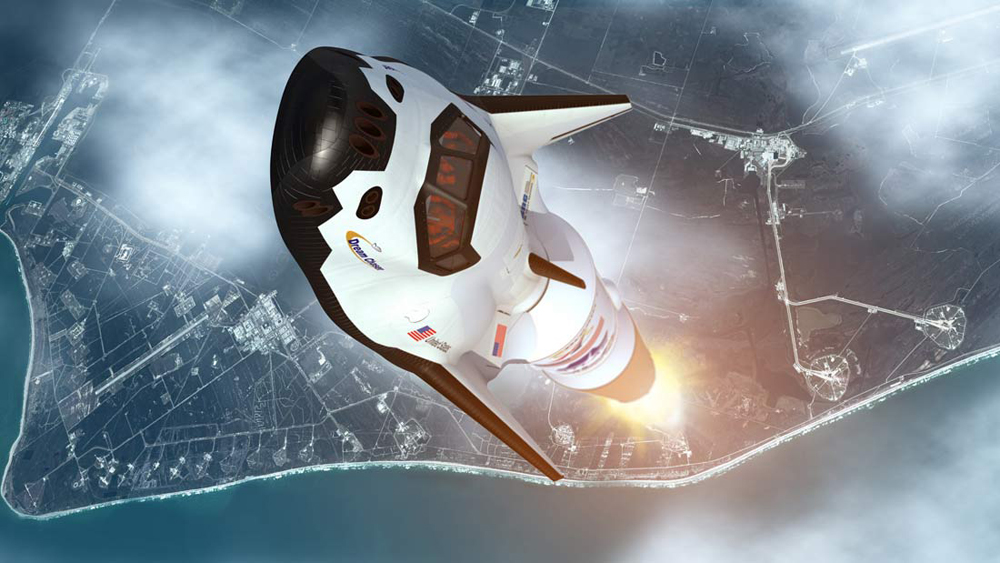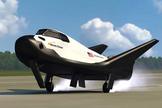
An artistic rendition of the Dream Chaser vehicle launching into space.
Credit: Sierra Nevada
Dream Chaser, a private spacecraft that looks like a stubby version of the space shuttle, is a concept being tested by Sierra Nevada Corp. based on NASA designs of a 1980s spacecraft prototype.
The spacecraft, which originally was developed by a company called SpaceDev, is among a group of ships that vied for private flights to the International Space Station. NASA funded SpaceX’s and Boeing’s concepts in 2014 for the last round of Commercial Crew Program development, sparking a formal protest from Sierra Nevada. In 2016, however, NASA selected Sierra Nevada, SpaceX and Orbital ATK for anticipated cargo missions to fly between 2019 and 2024. No specific flight awards have been made yet.
Once ready, Dream Chaser will carry up to seven people to the orbiting complex. It will launch vertically upon an Atlas 5 rocket and then, like the shuttle, land on a runway horizontally.
Based on secret Soviet design
Sierra Nevada, founded in 1963, describes itself as having expertise in electronics, avionics and communications systems. The Colorado-based firm has a space systems division that works on areas such as propulsion, small satellites and components for customers.

An artist’s depiction of the Dream Chaser vehicle landing on a conventional runway at the end of its mission.
Credit: Sierra Nevada
The spacecraft has a bit of a tangled history. Its design is based mainly on the HL-20 — a NASA spacecraft design from the 1980s that was itself based on a Soviet spacecraft called the BOR-4. But the HL-20 design was never used for space.
SpaceDev resurrected the design. According to Ars Technica , in 2006 the firm signed a licensing agreement with NASA to reuse HL-20 for the Dream Chaser concept.
“We have tried to make it clear that SpaceDev does have plans of our own in terms of human spaceflight, both orbital and suborbital,” said Jim Benson, the firm’s founding chairman and CEO, in a Space.com 2004 interview .
Despite the agency heritage, SpaceDev failed to get funding under the initial NASA Commercial Orbital Transportation Systems (COTS) program to fund commercial spacecraft. Benson left SpaceDev in 2006 to found a new space tourism company , but died in 2008 of a brain tumor.
SpaceDev, meanwhile, merged with Starsys Research Corp. and continued work with NASA under a non-reimbursable Space Act agreement in 2007.
That same year, it signed a memorandum of understanding with United Launch Alliance to put Dream Chaser on an Atlas 5 rocket. This entailed some design changes, but the companies were optimistic from the early days that this arrangement would work.
Sierra Nevada purchased SpaceDev in 2008, which added a new space systems business area to Sierra Nevada’s divisions.
“The acquisition of SpaceDev … represents a dynamic expansion of [Sierra Nevada]’s space technology capabilities,” stated Fatih Ozmen, Sierra Nevada’s chief executive, after the acquisition was finalized in December 2008.
“We believe that combining SpaceDev’s unique technological offerings, manufacturing capabilities and talented team with our existing space business and technology base will allow us to significantly increase our capacity and scalability while better serving our customers and making us a leader in space technology with access to a much wider customer and technology base.”
NASA money for development
In August 2012, Sierra Nevada was one of three companies that received money under the Commercial Crew Integrated Capability (CCiCap) award. CCiCap was the third phase of commercial crew development, and was supposed to help companies in the latter stages of spacecraft work to get their ships ready for flight. Sierra Nevada’s contract, which was worth up to $212.5 million, paid out money as the company progressed through certain milestones.
“We’re very pleased today to receive the award from NASA as a recognition of our work. We think the whole program is a very successful public-private partnership,” Mark Sirangelo, corporate vice president of Sierra Nevada’s space systems division, said Aug. 3, 2012, following the CCiCap announcement .
The company also passed several major tests in 2012, most notably a “captive carry” flight test where it rode below a helicopter. The spacecraft did a single glide test in 2013 where it was released from a helicopter and arrived at the runway, only to skid off and cause damage to the vehicle.
“We had a successful approach to the runway. The vehicle flared on cue and the speeds were perfect,” said Mark Sirangelo, corporate vice president and head of Sierra Nevada Corporation’s (SNC) Space Systems based in Louisville, Colo., in a Space.com interview in October 2013 .
“We hit the centerline exactly where we needed to be. On approach and landing, the left main gear did not deploy satisfactorily,” he added.
Credit: Karl Tate, SPACE.com Contributor
NASA protest
In September 2014, NASA announced the next and final phase of the commercial spaceflight program would see SpaceX’s Dragon and Boeing’s CST-100 spacecraft funded for the Commercial Crew Transportation Capability (CCtCap). The goal is to have the spacecraft ready to fly the International Space Station by 2017.
Sierra Nevada filed a protest Sept. 26, 2014, that temporarily halted work on commercial crew endeavors. The company said that Dream Chaser’s technical concept was equally as mature as at least one of the rival companies, and that there were “serious questions and inconsistencies in the source selection process.”
While the U.S. government allowed work to continue on commercial crew, the protest was reviewed by its General Accountability Office. In January 2015, the office said it would rule against Sierra Nevada .
“GAO disagreed with Sierra Nevada’s arguments about NASA’s evaluation, and found no undue emphasis on NASA’s consideration of each offeror’s proposed schedule, and likelihood to achieve crew transportation system certification not later than 2017,” part of the statement read.
Sierra Nevada’s response said, in part, that the company would continue to look for other customers for its contract.
“While the outcome was not what [Sierra Nevada] expected, we maintain our belief that the Dream Chaser spacecraft is technically very capable, reliable and was qualified to win based on NASA’s high ratings of the space system,” the company said in its statement.
In early 2016, NASA announced that Sierra Nevada (along with SpaceX and Orbital ATK) would all be listed as possible providers for cargo missions to ISS between 2019 and 2024. Specific flight awards haven’t been made yet.
“NASA has not yet ordered any missions, but will make a total of six selections from each menu of mission options at fixed prices, as needed,” NASA wrote in a statement at the time. “Each task order has milestones with specified amounts and performance dates. Each mission requires complex preparation and several years of lead time.”
The company is now working toward doing a second glide test in early 2016, but a firm date has not been released.
“SNC has made significant structural and systems improvements to the ETA including the composite wings and aeroshells,” Sierra Nevada wrote in October 2015. “SNC also invested heavily in maturing the spacecraft orbital avionics, guidance navigation and control, the flight software, and employed a number of new processes, all of which will be used on the orbital vehicle as well.”
The NASA contract also triggered a $36 million investment by the 22-nation European Space Agency. Once the agreement is signed, ESA will begin work building the first flight model of the International Berthing and Docking Mechanism (IBDM), which Sierra Nevada’s Dream Chaser Cargo System will use to attach itself to the space station.
Additional resources

Comments are closed.